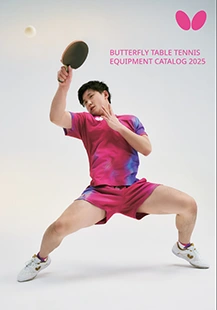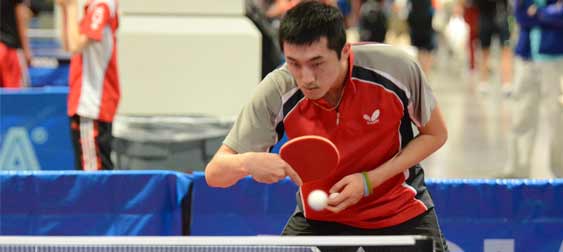Transitioning More Quickly
Butterfly Table Tennis Coaching
by Han Xiao
Usually, players above a certain level can practice very comfortably when they know where the ball is going. Although the quality of each player’s shots may vary, generally players can drill quite consistently when the drill is fixed. When drills become more randomized, some players have trouble transitioning when they aren’t sure where the next ball is going. This results in being late to the ball or making outright errors due to not being ready to hit the next shot.
The most common type of transition that players need to make is when they move laterally and need to cover both the forehand and the backhand side, with more advanced players also able to comfortably cover their middle. The drill that a lot of players will do to practice this a random drill with their partner blocking from the backhand corner. Another typical drill is one ball to the middle, one ball to either corner. Both of these popular drills can help work on lateral transitions. Some things to pay attention to when doing these drills include:
- Try to stand close to parallel to the table if possible when in neutral position. It’s necessary sometimes to have your dominant foot back a bit to hit forehands, but having this foot too far back will limit your options on the backhand side, making transitions from forehand to backhand very weak.
- When hitting or looping forehands against topspin, keep your arm above hip level if possible. Although it can take quite a bit of practice to keep the shoulder relaxed, drop the shoulder an appropriate amount, and still keep the arm relatively high, it can drastically improve your transitions both to the forehand side and to the backhand side. Dropping your arm too low can slow down your lateral transitions quite a bit.
- Don’t use too big of a backswing on the backhand side if you don’t have time. Try to keep things compact and use your wrist and forearm. Use only as much backswing as is necessary for the shot. Once you feel comfortable doing this, it will allow you to improve the quality of your backhands in quick exchanges, even under pressure from the opponent. It will also allow you to quickly transition from forehand to backhand without being late to contact the ball.
- Focus on having good shot quality. Although it isn’t directly related to the speed of your transitions, your shot quality definitely affects the quality of the opponent’s returns. If you’re simply putting the ball on the table, the opponent has the opportunity to put you under a lot of pressure. It’s very difficult to make quality shots and transition well when you’re under extreme pressure. However, if you put adequate spin or pace on your shots, the opponent will need to react to your pressure and you will find it much easier to transition when necessary. Even in practice, try to put appropriate quality on each ball without making too many unforced errors.
- Watch the ball at all times. Don’t try to guess where the next ball is going based on patterns. It’s alright to try to anticipate at times, but don’t start moving with your body until you see where the ball is headed. One misstep or wrong move with your body will negatively impact your transitions. Instead, watch the ball come off the opponent’s racket so you can react as quickly as possible and begin positioning yourself for your shot.
There are also transitions forwards and backwards, but many of the concepts are the same. Being able to keep yourself balanced, relaxed, and fluid goes a long way to having good transitions. Also, keeping your strokes as compact as possible without losing quality, not having wasted motion, and keeping your eye on the ball in order to react quickly will improve your ability to react and transition appropriately.
To see some of these points that we’ve talked about in action, here’s a video of Ma Long doing a random multiball drill. Pay special attention to Ma Long’s positioning, stance, and how he keeps his strokes compact and his arm high after the first loop against underspin. If you can master some of these concepts and improve your transitions, you will find that you can stay close to the table in the rally, put more pressure on your opponents, and perform better in competition.
























